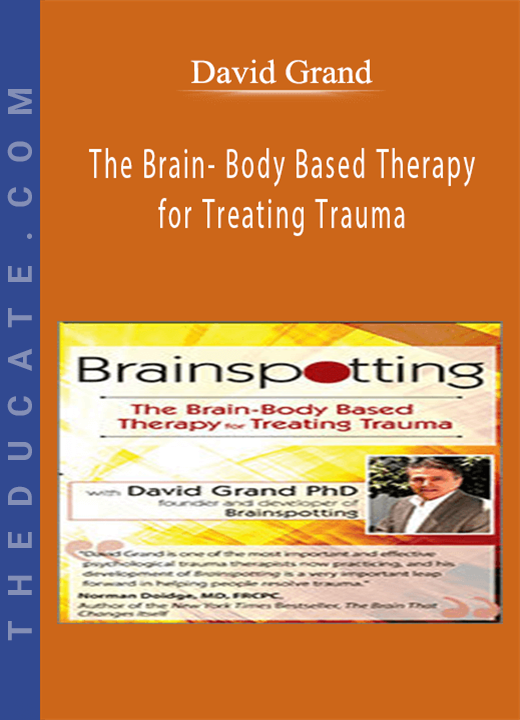Description

Brainspotting with David Grand, Ph.D.: The Brain- Body Based Therapy for Treating Trauma – David Grand
Here’s a typical scenario: at the end of the session, your client either responded well or not at all to treatment. And even those that responded well to treatment have often regressed by their next session. They’re angry – and you thought you had made a therapeutic gain.
If you’re like most therapists, you rely on talk therapy or a technical modality. What you are missing is the brain-body relation.
There is a new brain-based relational treatment approach developed by David Grand, PhD. that will give you more effectiveness as a therapist and avoid poor client responses.
Brainspotting is a powerful, focused treatment method that works by identifying, processing and releasing core neurophysiological sources of emotional/body pain, trauma, dissociation and a variety of challenging symptoms.
Trauma overwhelms the brain’s processing, leaving pieces of unprocessed experiences frozen in time. Brainspotting will provide you with powerful tools enabling your clients to quickly and effectively focus and process through the deep brain sources of many emotional, somatic and performance problems.
Where we look reveals critical information about what is going on in our brain. By carefully observing how and where clients look and focusing on the particular spot, this helps the client process disturbing material more gently and deeply.
Why is it better than many approaches?
- Flexible
- Bridges the gap between talk and technical modalities
- No protocols to master (like EMDR)
- Open and relational
- Responsive to the needs of the client
- Includes brain-body tools
- Can be adapted into any clinical approach and therapeutic style
- Access the clients visual field and somatic awareness to gain neurobiological attunement while enhancing relational attunement.
- Demonstrate three methods of attuning to clients visual field including Outside Window, Inside Window and Gazespotting.
- Use less intervention by accessing and trusting the clients innate brain-body healing capacity.
- Explain psychoeducation regarding the neocortex and subcortex with clients.
- Develop increased awareness of the counter-transferential activation of the flight, fight freeze response and how to adapt to it.
- Describe how to effectively use Brainspotting with clients with Dissociative and Attachment disorders.
What is Brainspotting?
- Brain-body based relational therapy
- Deeper, more powerful processing of trauma
- Brainspot – activity in the brain in response to focus and eye position
The Three Types of Brainspots
- Outside Window: Client unaware of therapist tracking reflex brainspots
- Inside Window: Client and therapist work together to find brainspots
- Gazespotting: Client has a fixed gaze while thinking or speaking
Reflexive Responses in Clients
- Eye wobbles
- Eye freezes
- Blinks
- Facial tics
- Brow furrowing
- Sniffs
- Swallows
- Head nods
- Body shifting
The Dual Attunement Frame
- Interpersonal Neurobiology
- Goal of brainspotting is accessing self-healing capacities
- Activate, locate and process the sources of trauma and distress in the body
- Unfreeze and release where the trauma is being held
- Gain direct access to midbrain processes for bottom up brain-body change
Process
- Activation
- SUDS Level (10-0)
- Location of activation in the body
- Location of eye position of greatest activity
- Focused Mindfulness (processing)







5 reviews for Brainspotting with David Grand, Ph.D.: The Brain- Body Based Therapy for Treating Trauma – David Grand
There are no reviews yet.